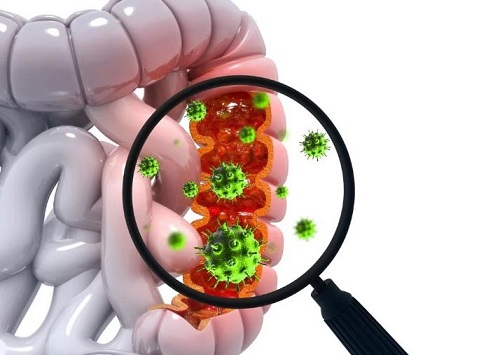Nikhil Prasad Fact checked by:Thailand Medical News Team Aug 05, 2024 8 months, 3 weeks, 15 hours, 2 minutes ago
COVID-19 News: COVID-19 has affected many organ systems, with varying mechanisms from direct viral effects to inflammation-induced changes. Among the commonly affected systems is the gastrointestinal (GI) tract, where diarrhea occurs in up to 50% of acute COVID-19 cases. This
COVID-19 News report explores the latest findings on COVID-19-induced diarrhea, providing insights into its pathophysiology and the roles played by direct viral effects and virus-induced cytokines, and will detail the key findings of a study conducted by researchers from Johns Hopkins University School of Medicine-USA and the University of New Mexico Health Sciences Center-USA, shedding light on the inflammatory nature of COVID-19 diarrhea.
 New insight into its causes of COVID-19-induced diarrhea
The Mechanism Behind COVID-19 Diarrhea
New insight into its causes of COVID-19-induced diarrhea
The Mechanism Behind COVID-19 Diarrhea
Researchers discovered that COVID-19 diarrhea results from a combination of direct viral effects and the virus-induced inflammatory response. The study utilized normal human enteroid monolayers exposed to live SARS-CoV-2 and virus-like particles (VLPs). These monolayers exhibited significant changes, including increased cytokine secretion and reduced mRNAs of key transport proteins such as ACE2, NHE3, and DRA.
Direct Viral Effects and Inflammatory Response
The live virus and VLPs increased cytokine secretion, including IL-6 and IL-8, which contributed to inflammatory responses in the GI tract. Interestingly, while VLPs and cytokines together caused chloride (Cl-) secretion, this process was calcium (Ca2+) dependent and independent of the cystic fibrosis transmembrane conductance regulator (CFTR). The study identified the involvement of the TMEM16 family of calcium-activated chloride channels in this process.
Live Virus Entry and Replication in Enteroid Monolayers
The study exposed the apical membranes of differentiated human duodenal and proximal colonic enteroid monolayers to live SARS-CoV-2. The virus entered and replicated within these cells, with higher replication levels observed in the small intestine compared to the colon. Viral entry was confirmed through the presence of intracellular double-stranded RNA and viral spike protein.
Cytokine Secretion Induced by SARS-CoV-2 Infection
Exposure to SARS-CoV-2 significantly increased the secretion of cytokines such as IL-6, MCP-1, and IL-1β from the duodenal enteroids. This cytokine secretion was also observed when the enteroids were exposed to IL-6 and IL-8, simulating a systemic inflammatory response. The study highlighted the crucial role of cytokines in the inflammatory response associated with COVID-19 diarrhea.
Impact on Transport Proteins and Ion Secretion
The live virus significantly reduced the mRNA levels of ACE2, NHE3, and DRA in the proximal colonic enteroids. Additionally, the protein expression of NHE3 and DRA was also reduced, while CFTR expression remained unaffected. These findings indicate that SARS-CoV-2 affects key transport proteins involved in ion transport, con
tributing to the diarrhea observed in COVID-19 patients.
The Role of Virus-Like Particles
To further investigate the mechanisms involved, the researchers utilized VLPs containing the four structural proteins of SARS-CoV-2. These VLPs replicated the effects of the live virus on cytokine secretion and transport protein expression. When combined with IL-6 and IL-8, VLPs significantly reduced the mRNA levels of ACE2, NHE3, DRA, and CFTR, mirroring the effects observed with the live virus.
Anion Secretion and the Role of Calcium
One of the notable findings of the study was the identification of VLP-induced anion secretion in the presence of IL-6 and IL-8. This secretion was dependent on calcium and was inhibited by specific inhibitors of the TMEM16 family of calcium-activated chloride channels. The researchers demonstrated that this anion secretion did not involve CFTR, highlighting the unique pathophysiology of COVID-19 diarrhea.
Insights from Irradiated SARS-CoV-2
The study also explored the effects of irradiated SARS-CoV-2, which is replication-deficient. While the irradiated virus did not significantly alter cytokine secretion or transport protein expression, it did induce intracellular calcium waves similar to those observed with VLPs. These findings suggest that viral replication is not necessary for certain proinflammatory responses and calcium-dependent processes.
Conclusion: Understanding COVID-19 Diarrhea
The study provides valuable insights into the pathophysiology of COVID-19 diarrhea, highlighting the roles of direct viral effects and the virus-induced inflammatory response. The unique features of COVID-19 diarrhea include its inflammatory nature, CFTR-independent chloride secretion, and the involvement of calcium-dependent processes. These findings pave the way for potential therapeutic strategies targeting the inflammatory response to manage COVID-19-related diarrhea.
The study findings were published in the peer-reviewed journal: Cellular and Molecular Gastroenterology and Hepatology.
https://pubmed.ncbi.nlm.nih.gov/39089626/
https://www.cmghjournal.org/article/S2352-345X(24)00138-3/pdf
For the latest
COVID-19 News, keep on logging to Thailand Medical News.
Read Also:
https://www.thailandmedical.news/news/sars-cov-2-spike-protein-impairs-gastrointestinal-tract-and-affects-mucosal-barrier
https://www.thailandmedical.news/news/flavonoids-epigallocatechin,-baicalin,-hesperetin,-luteolin-and-quercetin-helps-prevent-covid-19-induced-gastrointestinal-inflammation-and-diarrhea
